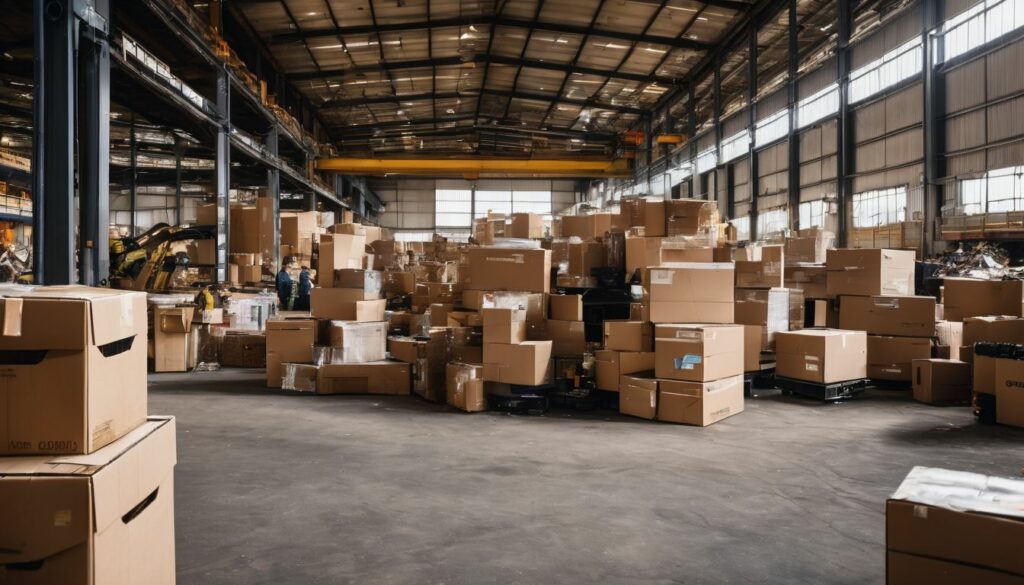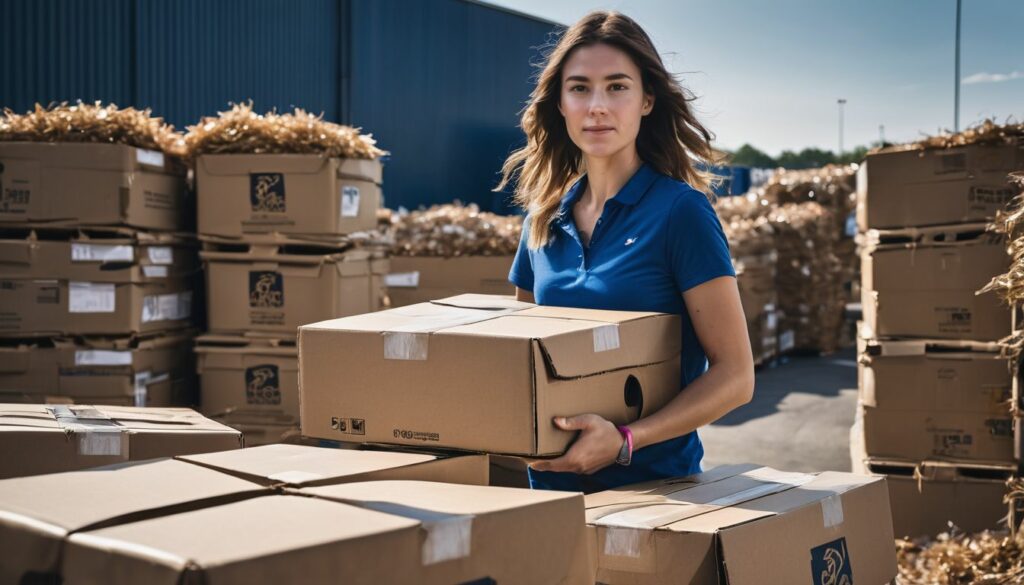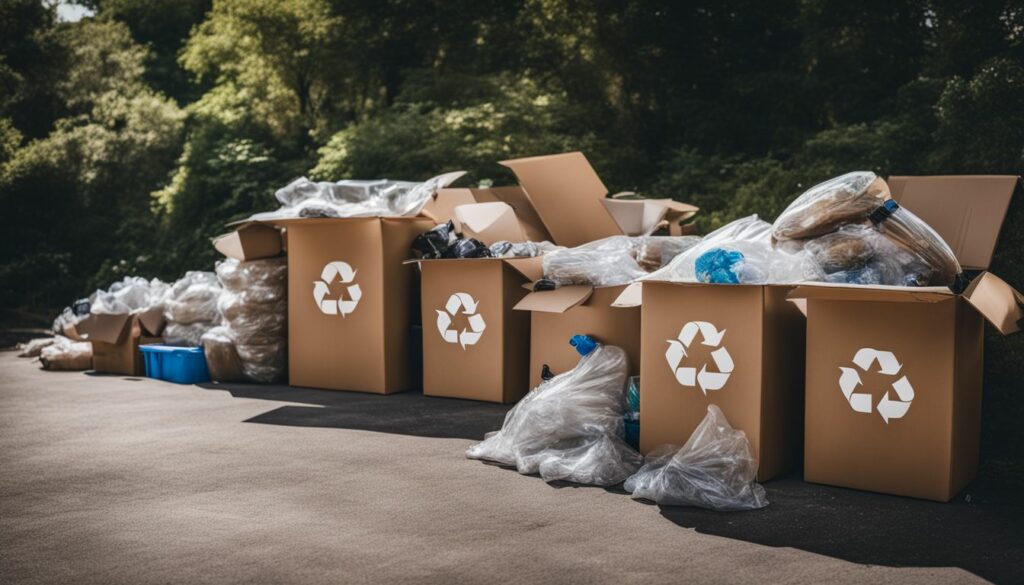
Struggling to figure out what to do with your piles of cardboard? In the UK, a staggering 71% of paper and cardboard packaging gets a new life through recycling. This post unpacks how you can join this movement, turning your cardboard waste into an environmental win.
Dive in and discover easy steps towards greener living!
Key Takeaways
- Recycling cardboard helps prevent it from ending up in landfills, reduces greenhouse gas emissions and uses less energy than producing new materials.
- Businesses can take advantage of recycling services, demonstrating their commitment to sustainable practices while potentially lowering production costs.
- It’s important for recyclable items like shipping boxes and paper rolls to be clean and free from contaminants such as food residue or plastic lamination before recycling.
- Certain items like greasy pizza boxes or wax-coated cardboard cannot be recycled because they contaminate the pulping process used in recycling facilities.
- By using recycled cardboard packaging, companies support the environment, enhance their brand image, and attract customers who value sustainability.
Understanding What Cardboard Items Can Be Recycled

Knowing which cardboard items can go into the recycling bin is crucial for effective waste management. Most cardboard products, such as shipping boxes, cereal boxes, and paper rolls, are recyclable.
Before placing them in your recycling bin, ensure these items are free from food residue and other contaminants. Unsoiled pizza boxes can be recycled, too; however, if they have grease or leftover food on them, they should not be mixed with clean recyclables.
Cardboard waste collection services often accept a variety of flattened corrugated materials. Pieces like brown paper bags also count as recyclable cardboard. Recycling centres handle boxboard used for packaging everyday items such as toothpaste or medication; make sure to remove any plastic windows or liners first.
As over 70% of the UK’s cardboard gets recycled multiple times before the fibres weaken, it’s important to contribute pure materials to keep this cycle efficient and eco-friendly.
Recognising Cardboard Items That Cannot be Recycled

Certain cardboard items may seem recyclable but should not go into the recycling bin. For instance, pizza boxes contaminated with grease cannot be recycled because the oil soaks into the fibre and interferes with the pulping process.
Likewise, any cardboard that has been coated with plastic lamination or wax is a no-go for recycling centres. This includes cartons for frozen foods and some takeaway containers.
Another common misconception involves shipping materials. While the cardboard is recyclable, protective elements like bubble wrap or polystyrene inserts aren’t suitable for standard cardboard recycling processes.
Also, remember to remove staples from cardboard always as these metal parts can damage machinery used in paper recycling facilities. Pay attention to such details to ensure that only appropriate types of cardboard make it through to help save energy and resources during production cycles at manufacturing plants.
The Process of Cardboard Recycling
Cardboard recycling involves collection, sorting, shredding and pulping, filtering, and finishing to transform used cardboard into new materials. Learn more about the detailed cardboard recycling process below.
Collection
Collection is the first step in the cardboard recycling process.
For residential customers, this starts with the kerbside collection. Businesses can work with companies such as Ecogen for a seamless cardboard collection service, where teams come equipped with industrial compactors that transform waste into large bales.
These tightly compacted cardboard bales save space and facilitate efficient transport to recycling facilities. Companies can schedule regular pickups tailored to their needs for maximum convenience, ensuring all recyclable cardboard materials are properly and promptly managed.
Recycle centres have the capability to recycle up to 70 tonnes of material per hour. By offering such robust services, they help businesses streamline their waste management practices while significantly reducing landfill usage.
This systematic approach means every piece of collected cardboard finds new life in recycled products instead of cluttering storerooms or harming the environment.
Sorting
During the sorting stage, workers at the recycling facility separate cardboard from other materials. They remove contaminants like tape, staples, and non-recyclable items such as waxed or plastic-coated paperboard.
Each cardboard type is sorted into different grades based on quality and condition. This ensures that only recyclable cardboard enters the next phase of processing.
Conveyor belts transport the sorted cardboard to be baled for easy handling. Industrial compactors press the material into large, manageable bales. Facilities can process up to 70 tonnes of material per hour in this way, creating tight bundles ready to be transformed back into usable sheets or new packaging solutions for businesses and consumers alike.
Baling makes storing and transporting recycled cardboard more efficient, allowing it to undergo further processing saving space in both warehouses and trucks while keeping collection areas tidy and organised.
Shredding and Pulping
Shredding dramatically transforms waste cardboard into a more usable state. Machines tear the material into small pieces, preparing it for the next stage in recycling. Pulping follows shredding, where the shredded bits are soaked in water and churned into a slushy mixture.
The consistency resembles porridge and provides an ideal base for creating new paper products.
Industrial setups ensure that pulped cardboard does not hit landfills but instead moves towards becoming something useful again.
The process efficiently turns old storage boxes and packaging into fresh sheets ready to enter the cycle anew, reducing pressure on our forests by limiting the need to fell trees for virgin paper production.
Filtering
During the filtering stage, workers at the recycling facility remove any impurities from the cardboard pulp. This step is crucial because it ensures that only clean, high-quality material reaches the next production phase.
Fine screens filter out contaminants like glue, staples or bits of plastic that might have been mixed with paper fibres during shredding and pulping.
To make recycled cardboard as strong and useful as new, advanced filtration systems capable of handling large volumes efficiently. The processed pulp must be thoroughly cleaned before being formed into new cardboard products; this includes stripping away inks and dyes through a series of chemical treatments and washes to ensure the final output meets industry standards for recycled content.
Recycling plants couldn’t satisfy the growing demand for eco-friendly packaging solutions across the UK without efficient filtering mechanisms capable of dealing with up to 70 tonnes per hour.
Finishing
After the cardboard has gone through filtering, it enters the finishing stage. Here, workers transform the cleaned and treated fibres into new cardboard sheets. Machines press them to create various layers depending on their intended use; some might become tough outer covers, while others form the wavy fluting that strengthens cardboard.
Then, large industrial rollers dry the sheets to complete their transformation.
The finished product is then wound onto massive reels ready for delivery worldwide or cut into size for specific uses. This sophisticated machinery can handle 70 tonnes of material every hour, turning old boxes and packaging into brand-new cardboard without any going to waste.
This continuous loop ensures that resources are maximised with minimal environmental impact as nothing heads to landfill – a testament to efficient recycling practices benefiting businesses and nature alike.
The Environmental Benefits of Cardboard Recycling
Recycling cardboard offers significant environmental benefits. It helps reduce the amount of cardboard ending up in landfills, reducing greenhouse gas emissions. Additionally, manufacturing cardboard from recycled materials saves a substantial amount of energy and uses less virgin material, contributing to the conservation of natural resources and preventing excessive use of forest resources.
Recycling cardboard also saves energy and reduces greenhouse gases, making it an environmentally friendly alternative that supports sustainable practices.
Furthermore, estimates suggest that recycling cardboard packaging can save between 25-50% of energy compared to manufacturing new products from raw materials. This process ultimately contributes to lower greenhouse gas emissions and minimises the impact on both natural resources and the environment as a whole.
The Business Advantages of Using Recycled Packaging
Using recycled packaging can present a range of benefits for businesses. By incorporating recycled materials into their packaging, companies can reduce the waste they generate and contribute to a more sustainable environment.
This appeals to environmentally conscious consumers and enhances a company’s brand image, demonstrating its commitment to reducing its environmental impact.
In addition, utilising recycled packaging materials can lead to cost savings for businesses. It often results in lower production expenses than virgin materials, which is especially beneficial for companies aiming to streamline their operations and improve their bottom line.
Furthermore, with the growing emphasis on eco-friendly practices, using recycled packaging can set a business apart from competitors and attract customers who prioritise sustainability in their purchasing decisions.
Conclusion
Recycling cardboard reduces energy consumption and greenhouse gas emissions. It also saves valuable resources by reusing materials. Cardboard recycling is a simple yet impactful way to contribute to environmental sustainability.
By correctly recycling cardboard, we can all play our part in reducing waste and protecting the planet for future generations.
FAQs
1. What items can I recycle as cardboard?
Recycle cardboard items like shipping boxes, cereal cartons, and office paper packaging. Avoid recycling cardboard soiled with food waste or covered in plastics and film.
2. How should I prepare my cardboard for recycling collections?
Flatten cardboard boxes, remove any tape or labels, and bundle them together if instructed by your council or recycling service, ensuring a cleaner collection job.
3. Can all types of cardboard be recycled?
Yes, most cardboard is recyclable, but check with local regulations as some cardboard treated with chemicals or heavy plastic layers might not be accepted.
4. Where can I find information on the price of recycling services?
For quotes on commercial recycling rates and fees for bins and collections, contact local providers directly through links provided by your council or look at their posted information online.
5. Is it better to reuse or recycle cardboard?
Reusing is often preferable; repurpose old boxes into storage containers, craft projects or create a compost at home before sending them for disposal through recycling.
6. How does recycling help the economy and environment?
Cardboard recycling reduces the amount of waste sent to landfills. It saves resources like wood from being used excessively, thus supporting the economy and positively affecting the environment.
